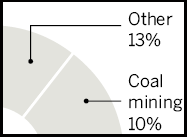CQ WEEKLY – IN FOCUS
June 9, 2012 – 12:42 p.m.
Gas Debate Sparks Data War
By Geof Koss, CQ Staff
For those frustrated by the inability of U.S. lawmakers to agree on ways to limit greenhouse gas emissions, the International Energy Agency last month delivered an unexpected bit of good news: While overall global emissions of carbon dioxide rose to a record high in 2011, U.S. levels actually fell by 1.7 percent. The IEA attributed the surprise dip to the widespread switch from coal to cleaner-burning natural gas for electricity generation — a trend facilitated by the drilling method known as hydraulic fracturing, which has unlocked enormous underground gas reserves previously thought to be off-limits.
But recent research suggests the IEA findings should include a caveat. Along with increased use of natural gas comes the widespread escape of methane, a greenhouse gas with a heat-trapping potential roughly 25 times that of CO2. That, critics say, cancels any climate benefits that result from replacing coal-fired generation.

|
||
|
That argument threatens to undercut one of the primary rationales for the expanded use of natural gas as a “bridge” between dirtier fossil fuels, such as coal and oil, and the widespread deployment of renewable-energy sources.
Although the natural gas industry says that recent estimates of “fugitive” methane emissions are inflated, a Cornell University professor told lawmakers last month that recent research vindicates his conclusion that natural gas produced by hydraulic fracturing, also known as “fracking,” may be more harmful to the climate than coal. “The methane emissions are worse than we said,” Professor Robert Howarth told a House subcommittee on May 31.
The climate concerns are the latest wrinkle in the debate over fracking, which involves injecting a large volume of water mixed with sand and chemicals deep underground to free the natural gas trapped in rock seams.
Widespread use of the technique has allowed the industry in recent years to tap vast underground reserves in the Midwest and eastern United States, flooding markets with a seemingly endless supply of cheap natural gas.
Rapid growth in U.S. natural gas production has shifted the economics of energy, providing a cheap and cleaner substitute for coal. Natural gas plants not only emit less conventional pollution than their coal-fired cousins, they also spew far less CO2 (half, by some estimates), which is the primary culprit in global warming.
Heated Debate
But as the use of fracking has grown, so have concerns about the accompanying air and water pollution. Industry officials maintain that current state regulation of fracking operations is adequate, but the IEA says it is essential to address mounting fears over methane leakage and other environmental concerns. “Improperly addressed, these concerns threaten to curb, if not halt, the development of unconventional resources,” the IEA said in a separate report released in late May.
The oil and gas sectors maintain that recent estimates of fugitive methane emissions cited by fracking critics like Howarth are wildly off the mark. For instance, the industry says, when the EPA last year recalculated its 2009 estimates of U.S. methane emissions using new oil and gas accounting methods, it led to a 204 percent increase in estimated greenhouse gas emissions for natural gas operations.
“We think it’s highly inaccurate,” said Sara Banaszak, vice president and chief economist at America’s Natural Gas Alliance, which, along with the American Petroleum Institute, last week released its own study, concluding that natural gas methane emissions were on average half of the EPA’s estimates.
The groups touted the broad sampling underlying the report, which was based on 91,000 wells over a broad geographic area. “We have a greater confidence in what this data tell us,” said Howard Feldman, API’s director of regulatory and scientific affairs, who said the EPA’s analysis rested on just 8,800 wells.
Gas Debate Sparks Data War
Putting forth its own data could strengthen the industry’s hand in fighting EPA efforts to crack down on pollution from fracking sites, which the agency can currently regulate only in narrow circumstances.
For instance, Feldman said, the API-ANGA data undercuts the cost-benefit claims the EPA used to formulate first-time air-quality standards for fracking operations released earlier this year. The EPA said in a statement that it would review the industry report but said its recent rule is “informed by extensive industry feedback and leverages technologies that are already widely deployed by producers.” The agency maintains that the regulation, when fully implemented, will reduce the bulk of methane and other toxins emitted from fracking sites.
The report also helps the industry counter mounting claims over the extent of methane leakage, much of which ANGA’s Banaszak said is based on outdated and limited EPA data. “To incorporate that data into different kinds of life-cycle analyses just builds bad analyses on bad data,” she said.
As several states consider limits on fracking and foreign nations consider tapping their own shale gas reserves, the industry report is but the latest volley in a growing debate.
“The issue of what the emissions are from the industry is not over,” Feldman said.